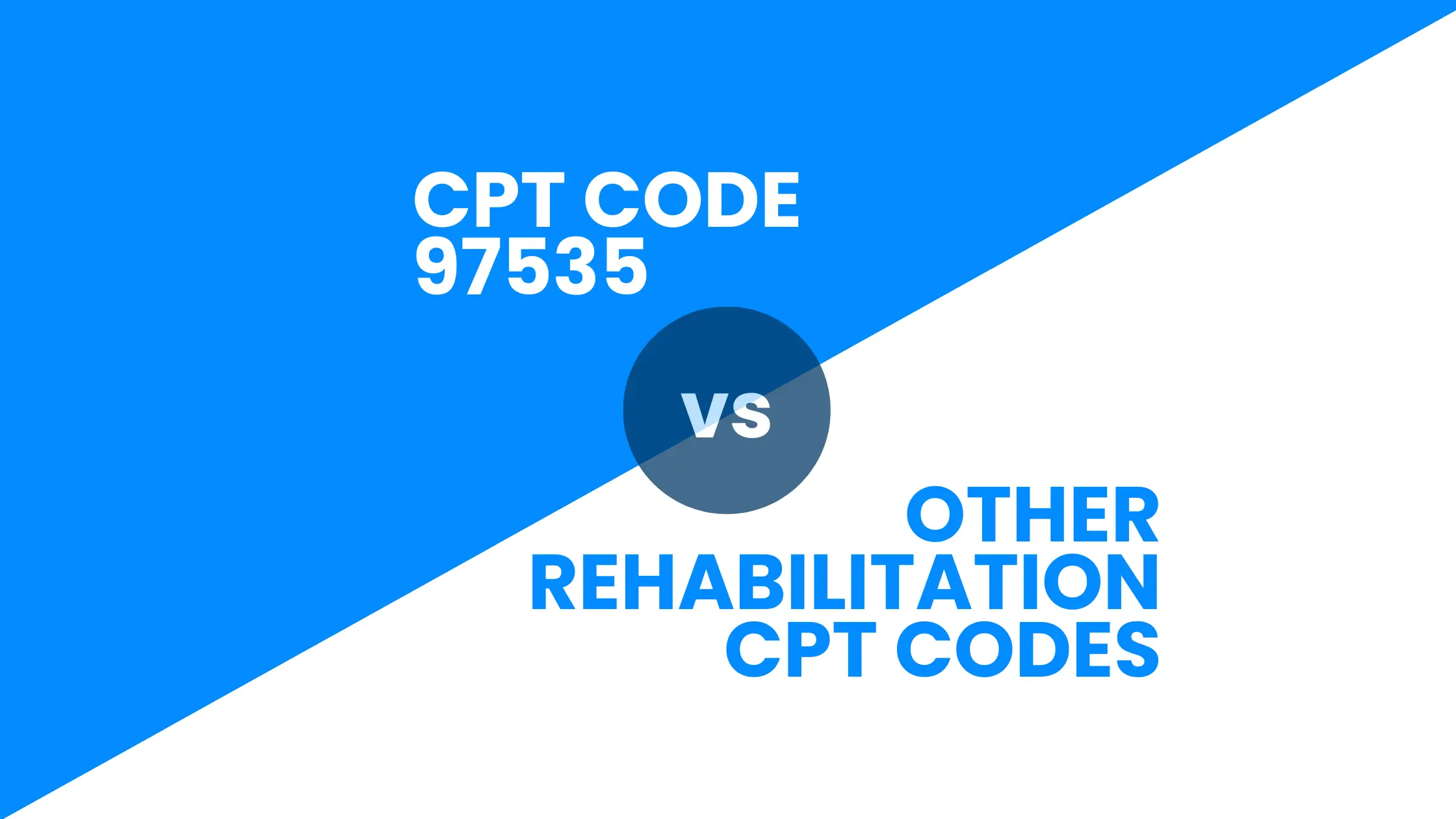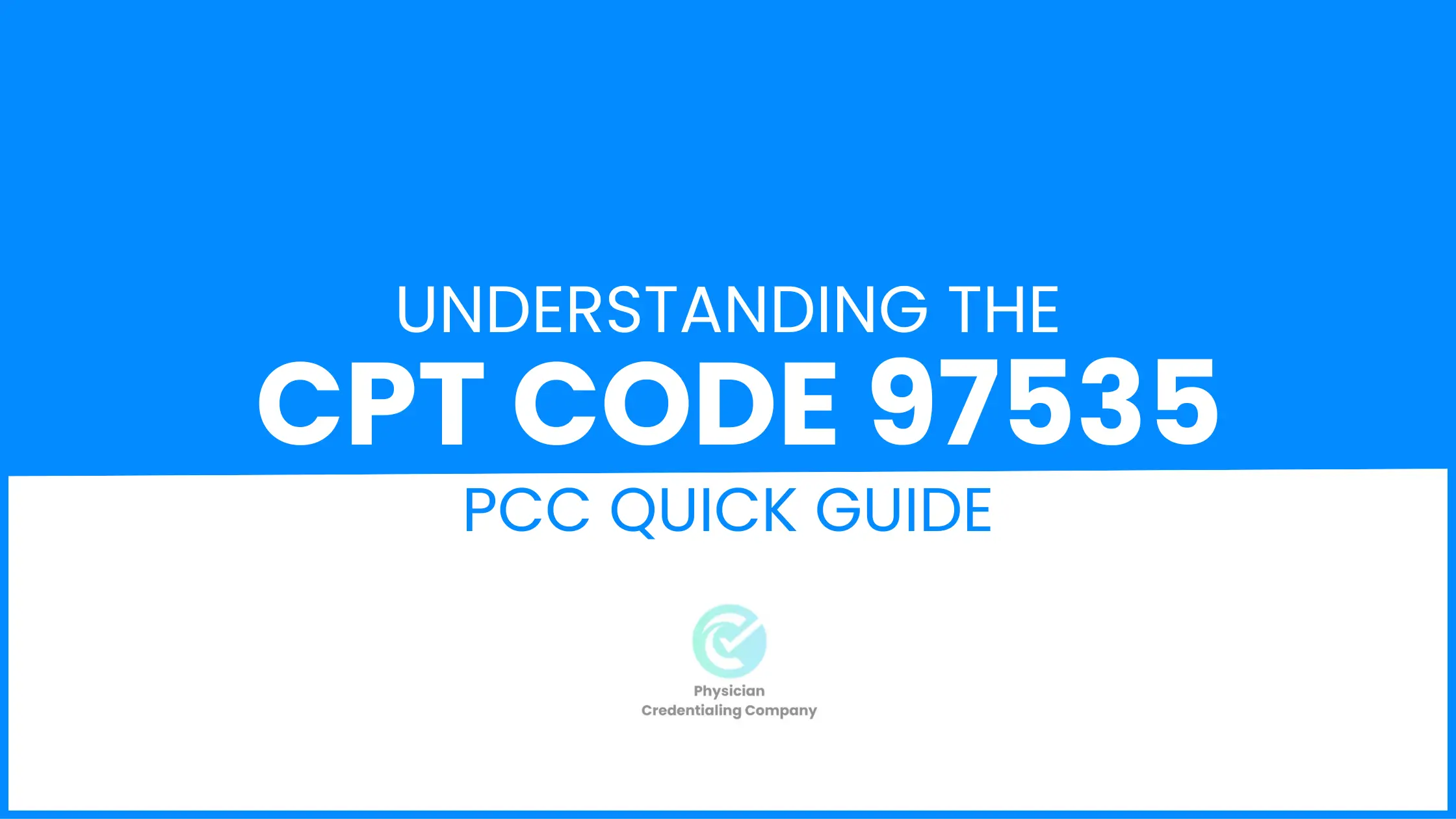Medical billing and coding is a complex and tough process, and severe challenges come with billing. A few decades back, medical services that were rendered to patients were described in the medical bills, but because of the lack of universality in mentioning the description of medical services, objections were being raised by the insurance companies on and off.
That confusion contributed a lot to claim denials and revenue loss. To overcome this problem, CPT codes are introduced to healthcare professionals. Each medical service is specified by one code, making the billing system universal. In therapeutic services like physical and occupational therapy services, the 97535 CPT code holds great significance. Rendered services are mentioned in the code form, and payers can extract the information from these codes and accept the claims A thorough understanding of billing and reimbursement is required to bill for this code.
In this PCC guide, we will learn the 97535 CPT code description, the concept of occupational therapy, and its billing requirements. We will also discuss various billing challenges and their solutions.
Understanding of 97535 CPT Code
97535 code is used by healthcare professionals for occupational and physical therapies given to patients with debilitating injuries or medical conditions that have affected their independence. CPT code 97535 defines self-care/ home management training. These training interventions include activities of daily living [ADLs], compensatory training, meal preparation, safety procedures, and instructions in the use of assistive technology devices. The main goal behind these interventions is to make the lives of patients better by managing their daily activities and lifestyles. This is 97535 CPT code description physical therapy basics which every healthcare professional should know before billing for services.
One-to-one contact between patient and doctor is necessary for billing this code. Rule 8 applies to 97535, which means that at least 8 minutes of meeting is necessary to bill for this code. If the time interval increases above this, it should be mentioned to bill for additional time and services.
Key Components of Self-Care/ Home Management Training
- Activities of Daily Life: These are activities of basic necessity to maintain a healthy and independent lifestyle. These activities include bathing, grooming, eating, toileting, and dressing. Without these activities, no man can survive, and these should be maintained with home management interventions.
- Compensatory Training: These are training in which alternative skills are taught to the patients for daily activities. Alternative skills are provided if they struggle to perform tasks due to any physical, cognitive, or sensory limitations. They are introduced to assistive devices and modified techniques.
- Safety Procedure: Safety should be the first priority if the patient has some mobility limitations. Fall prevention techniques, mobility aid tools, and emergency procedures are taught.
- Meal Preparation: If the patient is recovering from a stroke, injury, or surgery, then safe methods for meal preparations should be introduced to patients. The kitchen should be organized in the best possible way to prepare nutritious food.
Home management or self-care training is provided in various scenarios. Neurological conditions like stroke, multiple sclerosis, or brain injuries lead to activity limitations, and self-care interventions are preferred. Orthopedic injuries and post-surgery rehabilitation also require the use of 97535 CPT code occupational therapy.
Billing and Reimbursement Guidelines for CPT Code 97535
There are some specific guidelines of the federal government and insurance companies that healthcare professionals need to comply with to keep the process legal and accurate. Below are some considerations that should be kept in mind while billing for 97535:

1. Units of Time
Code 97535 refers to one-to-one interaction between patient and doctor with a specific time duration. Eight minutes is the minimum time to justify the use of CPT code 97535. Time can be increased, and generally, it is used in a 15-minute increment period. 97535 CPT code reimbursement rate depends on the time interval. Therefore, start and end times should be documented correctly to bill for this code. Any mistakes or errors can lead to claim denial. Medical necessity and documentation
It is essential that rendered services under the 97535 CPT code physical therapy are medically necessary. Adequate documentation is provided to the payers to justify that the patient has certain medical conditions that hinder him from doing daily tasks. The details of that medical condition and the need for self-care training should be documented and reported to payers. The therapy should not be for education but for functional improvements.
In medical necessity, the prior level of body functioning is mentioned in the documents. Positive outcomes leading to a decline in self-care should also be described in the papers. Repetitive occupational therapy sessions are not billable if the patient has achieved a specific level of independence in his daily activities.
There are a few things that are documented properly to comply with payer policies. These things include the type of training rendered, the use of any specific instrument, the detail of the task on which the patient was trained, and the results of the whole training. These factors clearly indicate the activity and meeting between the patient and doctor.
2. Payer-Specific Guidelines
Guidelines for billing 97535 CPT code occupational therapy may vary from one payer to another. It is recommended that all billing guides and rules be reviewed to get a clear understanding of their policies. All insurance companies do not cover every type of occupational therapy. It is in your best interest to check the patient’s insurance coverage. If your occupational service comes under their insurance plan, then you are good to go. Otherwise, claims cannot be accepted.
Some payers also ask for preauthorization before providing therapy sessions. Preauthorization plays an important role in avoiding overcrowding and useless therapy sessions. Therapists need to send a medical necessity report to the payers to allow for self-care training. Frequency and duration limitations also come under the way for billing 97535 CPT code physical therapy. The majority of insurers allow no more than six visits per month for specific diagnoses.
CPT 97535 vs. Other Rehabilitation CPT Codes
97535 is not only code used for rehabilitation and therapeutic training, there are many other CPT codes that are used to reduce the patient’s physical and mental limitations. Understanding each rehabilitation code is important for the correct use of code in the medical bills. 97535 is the CPT code, which is used for therapies aimed at improving the daily life activities of the patient.

- There is a 97110 therapeutic code, which is aimed at improving physical abilities. It is used to improve strength, flexibility, and range of motion. This code refers to the specific muscle or joint improvement after any injury or surgery.
- Another CPT code, 97530, refers to training to improve functional performance. These are task-oriented dynamic training, which involves improvement in coordination, range of motion, and balance. It is different from 97110 because it is aimed at just muscle or joint improvement, but it involves achieving a certain goal, like reaching a high shelf and getting in and out of the car. 97530 depends on physical activities rather than daily life activities as in 97535.
- 97112 CPT code refers to the neuromuscular improvements. This code is used for a patient who has survived a stroke, traumatic brain injury, or nerve damage and needs therapy to improve muscle function. If motor control is lost, then therapy sessions are provided to improve the coordination, function, and strength of muscles. This is billed by the 97112 CPT code.
CPT Code 97535 Billing Challenges
For billing 97535, one of the biggest issues healthcare professionals encounter has to do with time-based billing. Due to the fact that 97535 covers time, an accurate description of the time involved in offering the therapy should be included. To state the requirements, providers must record not only the amount of time spent on the training but also the self-care tasks that were taught during that amount of time. If time is not documented properly, it can lead to an audit or a denied claim. Some providers who have no clue about the general time-based billing guidelines end up losing potential revenue.
Assigning 97535 code for the services that actually meet the criteria for less complex code is a very common error. It is known as upcoding. It occurs due to human error or in a fraudulent manner to claim for a higher reimbursement rate. These errors can lead to financial damage to the patients and insurers. Good measures should be taken to avoid upcoding in the medical billing process.
Lack of necessary documentation and failure to comply with payer guidelines can also lead to claim denial. There are also many other policies regarding the therapist’s qualifications and session frequency or limitations. Policies and regulations regarding these factors are introduced periodically. For effective completion of these processes, providers should remain updated with new policies and comply with all regulations. This helps to reduce the claim denial rate and generates more revenue.
Conclusion
CPT code 97535 defines self-care/ home management training as the improvement of the daily activities of patients. It is used when there is a need to provide physical therapy sessions to patients who are experiencing some medical conditions or disability limiting their daily activities. Components of this training involve compensation therapy, improvement in daily life activities, meal preparation, safety procedures, and the use of assistive devices. It is indicated in stroke, brain injury, orthopedic injury, etc., patients to make their lives independent and easy.
97535 CPT code reimbursement rate depends on the time duration of a therapy session, type of payer, and geographical location. Understanding the difference between 97535 and other rehabilitation codes can help avoid upcoding and undercoding. Healthcare professionals must focus on the importance of accurate documentation and payer policies for effective medical billing. There are certain challenges like lack of knowledge about therapy time intervals, incomplete documentation, and upcoding. These challenges can be overcome by taking necessary measures. Also look into our professional credentialing services for physical therapy.
FAQ - People Also Asks
Ninety-seven thousand five hundred thirty-five code bills for the self-care/ home management training sessions. These sessions help the patients to learn how to do daily activities despite having physical or mental limitations. Knowledge about the use of assistive devices, supporting techniques, and meal preparation is provided to these patients in one-to-one meetings.
It is a time-based code for therapy sessions. Accurate documentation of session time intervals, medical necessity, and details about the type of interventions should be documented. Outcomes of therapy and specific payer policies should also be considered as important billing guidelines. To avoid claim denial, accurate use of code should be used in medical bills.
CPT code 97530 focuses on improving the patient’s goal-oriented functional abilities. Importance is given to improve strength, coordination, and balance of the body parts and enhance physical and functional performance. Meanwhile, 97535 is used to improve the patient’s ability to do daily life activities and make them independent. It is used to enhance self-care and home management tasks.

